
This review originally appeared in the Vol. 20 No. 2 / Fall-Winter 2013 issue of West 86th.
Exhibition:
Michael Landy: Saints Alive
National Gallery, London
May 23 – November 24, 2013
Catalogue:
Michael Landy: Saints Alive
London: National Gallery Company, 2013.
Distributed by Yale University Press.
80 pp.; 62 color ills.
Paper £9.99 / $15 EUR 39,80
ISBN: 9781857095609
Michael Landy: Saints Alive showcases drawings, an interactive torture device, and six over-life-size mechanical saints—at once comical, austere, violent, pathetic, intimidating—created by the British artist Michael Landy during his recently completed tenure as artist-in-residence at the National Gallery in London. This was a surprising partnership: on the one hand, an institution that enshrines the canon of Western painting from the Renaissance to the dawn of modernism; on the other, a conceptual artist who crashed the international art scene in 1988 as a member of the Young British Artists and who possesses no training or experience with painting. Underpinning these immediately apparent differences, however, is a more foundational challenge that fundamentally shapes the exhibition. Landy’s charge as artist-in-residence was to create works that responded to the museum collection, a task that presumes and affirms the status of the museum’s holdings as cultural treasures. Landy’s artistic practices, by contrast, have been deeply anti-materialistic, as exemplified by his best-known work, his 2001 performance Break Down, staged over two weeks in an empty London store, in which he and a team of assistants systematically catalogued and destroyed all of his possessions save the clothes he was wearing. In other work, he directs attention to objects rejected, overlooked, or forgotten: weeds (Nourishment, 2002), people and their dreams (Scrapheap Services, 1995–96), his own cancerous testicle (Radical Orchidectomy for a Solid Mass in the Upper Pole of the Left Testis, 2005), for example. Due to their treasured status, the paintings in the National Gallery inherently resist Landy’s customary artistic strategies that criticize contemporary materialism through the destruction and disposal of things. Landy, to sketch roughly the root problem he faced, could not simply incinerate a Cézanne.
The sculpture of St. Apollonia, a pale-faced virgin martyr who looms over the entrance to the exhibition, provides the arresting introduction to Landy’s solution: he transformed paintings of Christian saints into animated sculptures that perform the spectacle of their self-destruction. He lifted Apollonia from a painting by Lucas Cranach the Elder, where she appears with a demure melancholy. Here she becomes powerful and otherworldly: both physically elevated above us to roughly ten feet in height by her towering red dress and psychologically detached with downcast eyes and a severe expression. Her shoulders and upper chest have been sliced away, and in their place erupts a welter of gears and shafts. Her hands are clasped reverently before her, not to pray, but to grasp a long pair of pliers in which she holds a tooth. She cuts an austere, intimidating figure. The strong impulse is to leave her undisturbed and to walk respectfully around her. But the narrow space at the entrance of the gallery forces us uncomfortably near. If we venture closer, to where we fall under her indifferent gaze, we can activate her by stepping on a pedal. Then the jagged gears turn loudly. With a gruesome mechanical deliberateness she raises the pliers and then, with a sudden motion that makes her whole form shudder, violently drives the pliers against her mouth and yanks downward as if extracting a tooth. Her arms crank back, waiting to perform her torture for the next spectator.
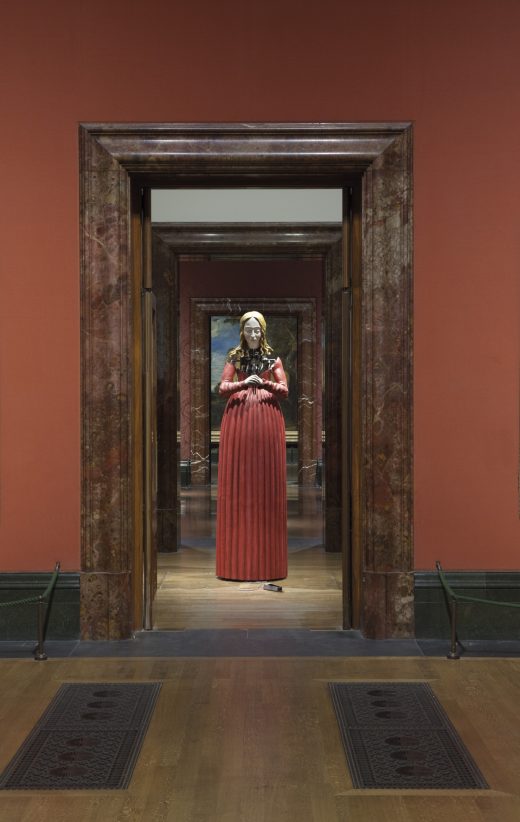
The five other mechanical saints in the gallery beyond Apollonia elicit the same complexity of response from viewers, and possess a similar presence and imaginative scope. There is Jerome, whose torso seems to have rocketed upward from the platform of his lower body upon a column of wheels, gears and pulleys. He has neither head nor left arm, but with his right he hammers savagely on his bared chest with a stone when activated. St. Thomas doubtfully probing Christ’s side is rendered as a disembodied hand on a mechanical arm that practically punches a torso set on a large rusty spring. Like a sacred punching bag, Christ’s body swings crazily when struck. St. Francis appears twice: as an animated donation box for visitors to drop coins into and, conversely, as a receptacle from which visitors can win a T-shirt by operating a mechanical claw. The archangel Michael, St. Lucy, Peter the Martyr, and St. Lawrence are combined into a single twirling, glowing, zapping, tilting, bashing contraption entitled Multi-Saint. St. Catherine, finally, is represented through a large wooden wheel studded with brutal teeth. Originally meant to shred the saint’s flesh, the Catherine wheel has been adapted by Landy as a wheel of saintly misfortune for visitors to turn. As a spectacle, the whole array is shocking but it does prompt reflection on the medieval distinction between the liberal and the mechanical arts; between “fine art” and craft, or engineering.
None of these works are inspired by the museum’s acknowledged masterpieces. Landy did borrow from lesser-known paintings by a few better-known artists who make it into survey texts—Cranach, Botticelli, and Hans Memling—but none possesses the recognition among the general public enjoyed by artists such as Caravaggio or Monet. The other paintings that Landy references were produced by figures known primarily to scholars: Sasetta, Ercole de’Roberti, Cosimo Tura, Cima da Conegliano, Carlo Crivelli, Pinturicchio. In selecting the paintings from which he draws inspiration, Landy thus pursues his fascination with things overlooked, and at the same time succeeds in opening visitors’ eyes to paintings they would otherwise almost certainly pass over.
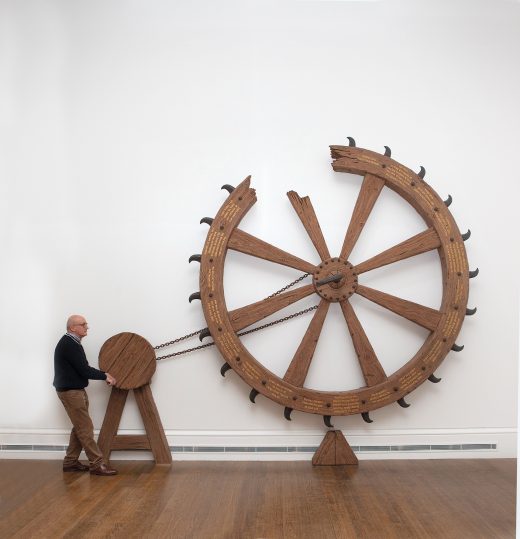
Landy’s sculptures also riotously trample taboos of comportment in traditional art museums. We can see—but never touch—the paintings at the National Gallery. Yet we are invited to touch Landy’s works to activate and thereby complete them. They then turn, shudder, and bang away at themselves with a noisy abandon that travesties the reverential hush observed in the museum’s other galleries. The mechanical Dadaist contraptions of Jean Tinguely (1925–91) inspired Landy to animate his saints. Saint Jerome, for instance, is a close relative of Tinguely’s famed Homage to New York, which was designed to self-destruct while performing a set of disconnected and useless tasks when exhibited in the garden of MoMA in 1960. In the staid setting of the National Gallery, which celebrates tradition rather than the avant-garde, Landy’s work appears far more transgressive. Experiencing his sculptures can be bewildering and disconcerting, but also interjects elements of playfulness and fun often lacking in the pious contemplation of masterpieces of art history. The works in Saints Alive seem cheeky as a result, mocking habits of respectable art-viewing while also serving as kooky send-ups of Old Master paintings and even the religious figures they portray.
At the same time Landy’s creations are deeply serious. While the immediate impact of the exhibition mixes large doses of the surprising, bizarre, and comical, pausing to reflect upon what the objects represent and what they do pulls in a more sobering direction, toward considerations of destruction and worldly renunciation. Of all the possible subjects pictured in the National Gallery, the exclusive focus upon representations of Christian saints signals the sympathy between these holy figures and Landy’s artistic practices, if not Landy himself. His drawings and collages for the project, displayed on the walls of the entrance gallery around St. Apollonia, manifest clearly this connection. In Saint Catherine Wheel Dump, notably, Landy created a collage of the thirty-three Catherine wheels he had found in the museum’s paintings. He cut the wheels from large color reproductions and assembled them into a pile of the smashed torture devices. Mutilating reproductions to produce the collage allowed Landy to enact symbolically the destruction performed in actuality in works such as Break Down. The process also expressed, perhaps, his antagonism to the weight of art history. The finished collage, moreover, envisions a fantasy dump site for broken paintings, which conceptually resembles Landy’s Art Bin, a huge container installed in 2010 in a South London gallery in which any artist, famed or amateur, is invited to dispose of failed work.
Preservation, however, is inextricably twined about the visions of destruction in Saints Alive. When Landy discovered two more paintings with Catherine wheels he created a revised drawing of the dump that included all thirty-five wheels. Recording every smashed wheel with thorough diligence potentially forces viewers of the drawings to acknowledge every example that could be overlooked or abandoned. This exposes a defining tension in Landy’s work especially critical to this exhibition: by centering his practice on things forgotten or destroyed he preserves them in art and memory. Even in the nihilistic Break Down Landy carefully catalogued and weighed all 7,227 items that were destroyed. There is no absolute annihilation in his work: no destruction without forgetting. Still, he simultaneously insists unflinchingly upon the transience of objects and the memories or presences invested in them: no permanence can be preserved in material things. All of the saints in the exhibition are snared in this tension. Landy has brought these saints—and the paintings they appear in—back to life and memory by embodying them as mechanical figures. Yet they are renunciatory saints, ardently desiring to escape the temptations of the world, and so Landy has created them performing their own self-destruction. The humor and absurdity of the figures as a result gives way to pathos and tragedy.
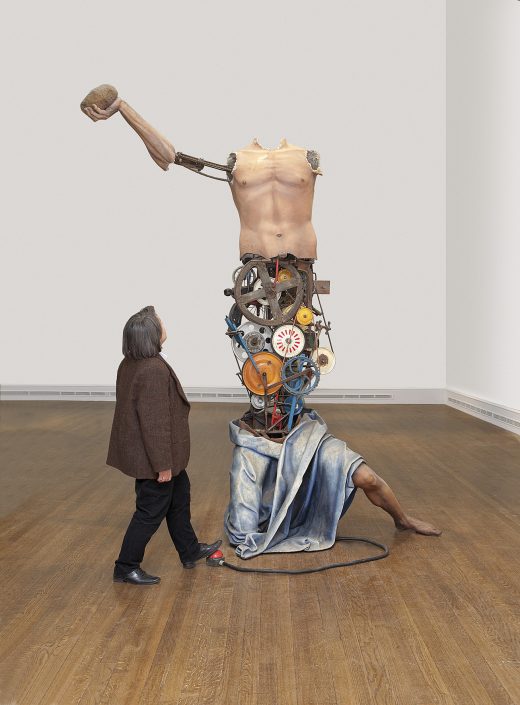
The two sculptures of St. Francis enact most effectively the irresolvable conflict between the urges to search for permanence in things and to escape from the world of materiality. The works possess this distinct edge because they engage most directly with our consumer culture, and they are for Landy almost autobiographical. In an interview from the exhibition catalogue, Landy mentions his awareness of the parallel between the destruction of his possessions in Break Down and Francis’s renunciation of his large inheritance (41). Reflecting perhaps on the irony that Break Down became a phenomenal success in the art world, Landy in Saints Alive uses St. Francis to express the futility of such feats of abnegation. For one sculpture, the most understated in the show, Landy takes a figure of St. Francis staring fixedly at a crucifix held in his hands and replaces his lower body with a plexiglass donation box. Inserting a coin causes Francis to whack himself hard in the forehead with the cross. In the other piece, Francis appears headless as a kneeling figure ecstatically receiving the stigmata. Pressing a pedal causes a mechanical claw to slide along a small beam and drop into a gaping hole where his head should be. With luck the claw will pull a Landy-designed T-shirt from the saint’s body cavity and drop it on the floor for the visitor to take home. The shirt features the knotted cord worn around the waist by Franciscans but tied instead around the neck of the shirt as if it were a noose. Trailing down the front are the three knots of the cord labeled with the virtues they symbolize: poverty, chastity, and obedience.
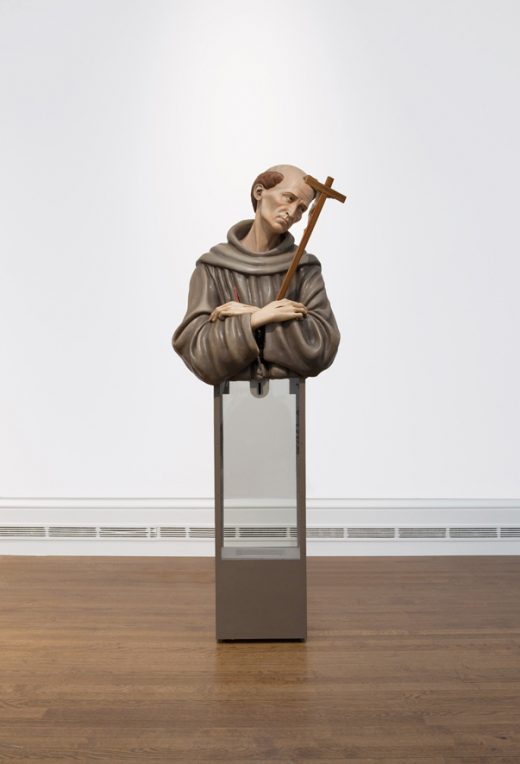
Francis yearned for poverty, but here he collects money as a donation box for the National Gallery. Through self-punishment he seems to express regret, or perhaps it is we, the visitors dropping in our money, who cause him harm. Francis gave away his clothes and possessions, and the other sculpture perpetuates this act of charity. But his body has also become a prize bin with T-shirts on which the Franciscan virtues are written like a designer’s motto—the designer in this case being the famous artist named Michael Landy. The works thus capture St. Francis’s inability to escape the world of things, which shades into Landy’s inability to escape from the ineluctable force of the art market and creeping commodification. Francis, for his part, falls to his knees not in awe before God as he receives the stigmata, but in submission to a grasping, acquisitive claw that seeks a memento—and a possibly valuable art object—for the visitor who pushed the pedal.
The animated saints clearly wrestle with the obsessive accumulation of possessions characteristic of contemporary society, but Landy’s works also potentially transcend our historical moment, as demonstrated by their strikingly medieval qualities. The resemblance extends beyond any shared Christian subject matter to include the functions of a privileged class of medieval objects: relics and their containers, known as reliquaries. Relics, like the recycled wheels and gears of Landy’s saints, were mostly bits of trash: shards of bone, a shriveled finger, scraps of filthy cloth, strands of hair, or a splinter of wood were typical. Their value pointedly resided not in their material, but in their origins as parts either of a saint’s body or of objects the saint had come in contact with. Because of these origins, medieval relics possessed the capacity to make long-departed saints present and accessible, so that they could hear and respond to the prayers and needs of devotees. The spiritual value of a relic was often communicated by the worldly value of the reliquary that held it: skillfully worked forms and precious materials such as gold, gems, ancient cameos, and brilliant enamels displayed the sacred power and heavenly character of the physical detritus within. If we compare Landy’s sculptures to the thirteenth-century reliquary bust of St. Yrieix, for instance, we can see a similar cumulative aesthetic and density of attentiveness in the piling up of forms, shapes, and objects. Although Landy eschews preciousness, his mechanical animation of the saints strongly echoes the dynamic capacities of medieval reliquaries. The reliquary of Yrieix, a venerated sixth-century figure from the region around Limoges in central France, does not literally move. But the reliquary viscerally reaches out toward those before it with its wide, staring eyes. Medieval arm-shaped reliquaries, another popular form, engage viewers with gestures of speech or blessing. These forceful ocular and manual gestures would be further animated in processions and rituals during which the reliquaries would be physically moved. Landy’s saints similarly focus on heads and hands as vehicles for animated expression, and the pressing of pedals to activate the figures is a participatory analogue to medieval practices of moving reliquaries.
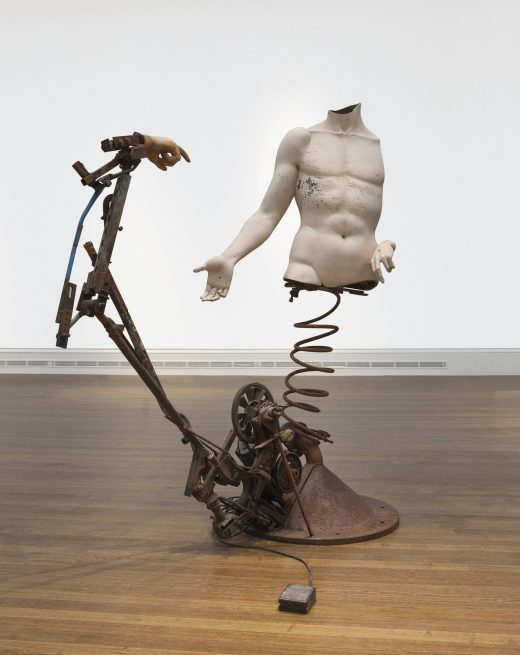
The comparison of Landy’s creations to medieval relics and reliquaries could be pursued in other directions. Is there a parallel, for example, between contact with a saint that makes an object a relic, and Landy’s transformation of junk into art? Landy briefly mentions reliquaries in the aforementioned interview, but did these kinds of medieval objects play a formative role in shaping his work (52)? But the comparison bears most pressingly upon the tension in Landy’s work between presence embodied in material things and renunciation or loss. The medieval cult of relics and the use of reliquaries developed in large part as an answer to worshippers’ yearnings for close contact with the sacred and divine. Even as these relics and reliquaries established the presence of a holy person, however, they confronted viewers with absence. Medieval saints were embodied primarily as fragments: relics themselves were almost always bits of matter, and many reliquaries took the form of a body part, usually a head or arm. Encountering St. Yrieix’s gleaming face makes him present, but also makes us aware that the rest of his body is not here, just as his shining angelic visage reminds us that he now resides in heaven, not on earth. Landy’s saints, too, are fragmented material presences. Powerfully manifest through their scale and animation, they are also patently absent in their incomplete, mechanical nature.
The comparison of medieval and modern embodiments of saints hints at a long history of deeply conflicted impulses in how people have related to material objects. Much of Landy’s work has scrutinized how contemporary society encourages us to form our identity around our possessions, and how this conversely leads to people being treated like disposable objects—a modern fate that is as harsh as any martyrdom. In Saints Alive he balances these concerns with their diametric opposite: the impossibility of fully escaping the world of things. Like St. Francis collecting coins and distributing T-shirts today or the bones and resplendent reliquary that kept Yrieix anchored to earth in the Middle Ages, objects come back to haunt those who would reject them. The conflicting impulses are tragic not merely through their coexistence, but also because each is in itself unattainable. In the end, these failures of purpose are what make Landy’s works most successful. The sculptures fail literally in that they often cease working during the course of the day (so visit in the morning if you wish to see them all operational). The failures certainly frustrate some visitors, but the failures also make Landy’s creations more human. Is the absurdity of a machine made to destroy itself a metaphor for the human condition? Instead of the modern mechanical virtues of elegant simplicity and efficiency, the saints bristle with old wheels and gears that seem far more than necessary. As saints, Landy’s absurd machines become poignantly human: like us they are inefficient, flawed, and break down.
Kerry Boeye, a medievalist, is assistant professor of art history at Loyola University of Maryland.
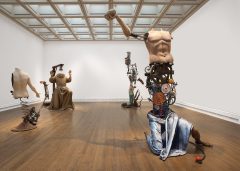
Installation of Saints Alive at the National Gallery, 2013. Michael Landy, courtesy of the Thomas Dane Gallery, London. © Michael Landy, courtesy of the Thomas Dane Gallery, London. Photo: The National Gallery, London.
